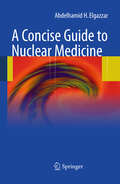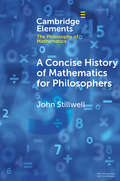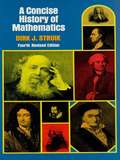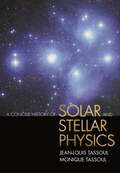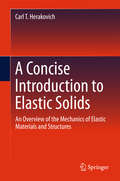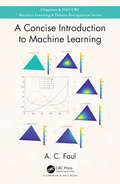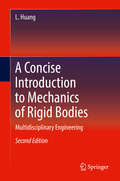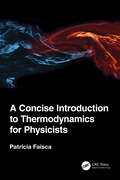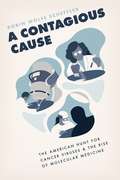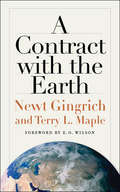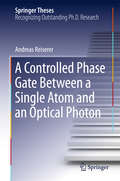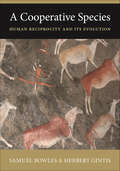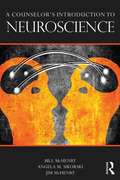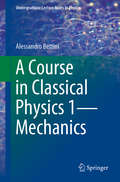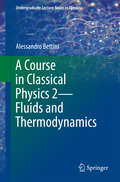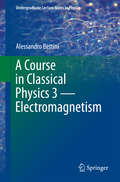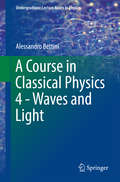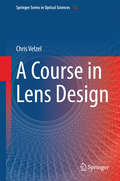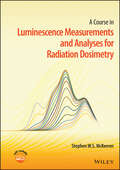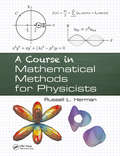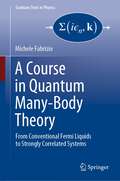- Table View
- List View
A Concise Guide to Nuclear Medicine
by Abdelhamid H. ElgazzarNuclear medicine is an important component of modern medicine. This easy-to-use book is designed to acquaint readers with the basic principles of nuclear medicine, the instrumentation used, the gamut of procedures available, and the basis for selecting specific diagnostic or therapeutic procedures and interpreting results. After an introductory chapter on the history, technical basis, and scope of nuclear medicine, a series of chapters are devoted to the application of nuclear medicine techniques in the different body systems. In addition, the use of nuclear medicine methods within oncology is carefully examined, covering diagnosis, staging, assessment of treatment response, radiotherapy planning, and the sentinel node technique. The book concludes with a chapter devoted to nuclear medicine therapy. This practical and up-to-date guide to nuclear medicine is ideal for beginners and will also help professionals who need to retrieve useful information rapidly.
A Concise Guide to the Mental Capacity Act: Basic Principles in Practice
by Dr Tracey Ryan-MorganThis book provides a clear introduction to the Mental Capacity Act (MCA, 2005), offering an easy reference guide to the complex issues enshrined within the Act to inform the everyday practice of those who need to perform within its parameters as part of their day-to-day work. Bringing together clinical neuropsychology expertise with legal commentary, the book introduces the main principles and presumptions of the MCA (2005) and describes the processes involved in the comprehensive assessment of what can, in practice, be complex issues. It provides learning summaries, flowcharts, checklists and web references for easy to access resources. The chapters also contain a broad range of illustrative case examples with considerable emphasis given to those areas of complexity that are not addressed in current guidance and which often prove contentious in everyday practice, such as how particular forms of brain injury can lead to hidden difficulties with decision-making which can be challenging to assess and evidence in practice. The book is essential reading for trainee nurses, doctors, paramedics, social workers, lawyers, psychologists and health and social care support workers, as well as experienced health and social care professionals such as ward managers and care and nursing home managers who face mental capacity issues in their day to day working role.
A Concise History of Mathematics for Philosophers (Elements in the Philosophy of Mathematics)
by John StillwellThis Element aims to present an outline of mathematics and its history, with particular emphasis on events that shook up its philosophy. It ranges from the discovery of irrational numbers in ancient Greece to the nineteenth- and twentieth-century discoveries on the nature of infinity and proof. Recurring themes are intuition and logic, meaning and existence, and the discrete and the continuous. These themes have evolved under the influence of new mathematical discoveries and the story of their evolution is, to a large extent, the story of philosophy of mathematics.
A Concise History of Mathematics: Fourth Revised Edition (Dover Books on Mathematics)
by Dirk J. StruikThis compact, well-written history -- first published in 1948, and now in its fourth revised edition -- describes the main trends in the development of all fields of mathematics from the first available records to the middle of the 20th century. Students, researchers, historians, specialists -- in short, everyone with an interest in mathematics -- will find it engrossing and stimulating.Beginning with the ancient Near East, the author traces the ideas and techniques developed in Egypt, Babylonia, China, and Arabia, looking into such manuscripts as the Egyptian Papyrus Rhind, the Ten Classics of China, and the Siddhantas of India. He considers Greek and Roman developments from their beginnings in Ionian rationalism to the fall of Constantinople; covers medieval European ideas and Renaissance trends; analyzes 17th- and 18th-century contributions; and offers an illuminating exposition of 19th century concepts. Every important figure in mathematical history is dealt with -- Euclid, Archimedes, Diophantus, Omar Khayyam, Boethius, Fermat, Pascal, Newton, Leibniz, Fourier, Gauss, Riemann, Cantor, and many others. For this latest edition, Dr. Struik has both revised and updated the existing text, and also added a new chapter on the mathematics of the first half of the 20th century. Concise coverage is given to set theory, the influence of relativity and quantum theory, tensor calculus, the Lebesgue integral, the calculus of variations, and other important ideas and concepts. The book concludes with the beginnings of the computer era and the seminal work of von Neumann, Turing, Wiener, and others."The author's ability as a first-class historian as well as an able mathematician has enabled him to produce a work which is unquestionably one of the best." -- Nature Magazine.
A Concise History of Solar and Stellar Physics
by Monique Tassoul Jean-Louis TassoulThis book provides a comprehensive overview of the history of ideas about the sun and the stars, from antiquity to modern times. Two theoretical astrophysicists who have been active in the field since the early 1960s tell the story in fluent prose. About half of the book covers most of the theoretical research done from 1940 to the close of the twentieth century, a large body of work that has to date been little explored by historians. The first chapter, which outlines the period from about 3000 B.C. to 1700 A.D., shows that at every stage in history human beings have had a particular understanding of the sun and stars, and that this has continually evolved over the centuries. Next the authors systematically address the immense mass of observations astronomy accumulated from the early seventeenth century to the early twentieth. The remaining four chapters examine the history of the field from the physicists perspective, the emphasis being on theoretical work from the mid-1840s to the late 1990s--from thermodynamics to quantum mechanics, from nuclear physics and magnetohydrodynamics to the remarkable advances through to the late 1960s, and finally, to more recent theoretical work. Intended mainly for students and teachers of astronomy, this book will also be a useful reference for practicing astronomers and scientifically curious general readers.
A Concise Introduction to Elastic Solids: An Overview of the Mechanics of Elastic Materials and Structures
by Carl T. HerakovichThis book provides an introduction to fundamental concepts of solid mechanics for the uninitiated. It also includes a concise review of fundamentals for those who have been away from the field for a time or are studying for a final exam or engineering license exam. The coverage ranges from fundamental definitions through constitutive equations, axial loading, torsion, bending, thermal effects, stability, pressure vessels, plates and shells, computational mechanics, and fibrous composite materials.
A Concise Introduction to Machine Learning
by A.C. FaulThe emphasis of the book is on the question of Why – only if why an algorithm is successful is understood, can it be properly applied, and the results trusted. Algorithms are often taught side by side without showing the similarities and differences between them. This book addresses the commonalities, and aims to give a thorough and in-depth treatment and develop intuition, while remaining concise. This useful reference should be an essential on the bookshelves of anyone employing machine learning techniques. The author's webpage for the book can be accessed here.
A Concise Introduction to Mechanics of Rigid Bodies: Multidisciplinary Engineering
by L. HuangThis updated second edition broadens the explanation of rotational kinematics and dynamics -- the most important aspect of rigid body motion in three-dimensional space and a topic of much greater complexity than linear motion. It expands treatment of vector and matrix, and includes quaternion operations to describe and analyze rigid body motion which are found in robot control, trajectory planning, 3D vision system calibration, and hand-eye coordination of robots in assembly work, etc. It features updated treatments of concepts in all chapters and case studies. The textbook retains its comprehensiveness in coverage and compactness in size, which make it easily accessible to the readers from multidisciplinary areas who want to grasp the key concepts of rigid body mechanics which are usually scattered in multiple volumes of traditional textbooks. Theoretical concepts are explained through examples taken from across engineering disciplines and links to applications and more advanced courses (e. g. industrial robotics) are provided. Ideal for students and practitioners, this book provides readers with a clear path to understanding rigid body mechanics and its significance in numerous sub-fields of mechanical engineering and related areas.
A Concise Introduction to Thermodynamics for Physicists
by Patricia FaiscaThis introductory textbook provides a synthetic overview of the laws and formal aspects of thermodynamics and was designed for undergraduate students in physics, and in the physical sciences. Language and notation have been kept as simple as possible throughout the text. While this is a self-contained text on thermodynamics (i.e. focused on macroscopic physics), emphasis is placed on the microscopic underlying model to facilitate the understanding of key concepts such as entropy, and motivate a future course on statistical physics. This book will equip the reader with an understanding of the scope of this discipline and of its applications to a variety of physical systems Throughout the text readers are continuously challenged with conceptual questions that prompt reflection and facilitate the understanding of subtle issues. Each chapter ends by presenting worked problems to support and motivate self-study, in addition to a series of proposed exercises whose solutions are available as supplementary material. Features Pedagogically designed, including illustrations, keyword definitions, highlights, summaries of key ideas and concepts, and boxes with additional topics that complement the materials presented in the main text. Presents active reading strategies, such as conceptual problems, discussion questions, worked examples with comments, end of chapter problems, and further reading to stimulate engagement with the text. Guides the reader with ease through a difficult subject by providing extra help whenever needed to overcome the more demanding technical and conceptual aspects. Solutions Manual available upon qualifying course adoption.
A Concise Introduction to the Statistical Physics of Complex Systems (SpringerBriefs in Complexity)
by Eric BertinThis concise primer (based on lectures given at summer schools on complex systems and on a masters degree course in complex systems modeling) will provide graduate students and newcomers to the field with the basic knowledge of the concepts and methods of statistical physics and its potential for application to interdisciplinary topics. Indeed, in recent years, statistical physics has begun to attract the interest of a broad community of researchers in the field of complex system sciences, ranging from biology to the social sciences, economics and computer science. More generally, a growing number of graduate students and researchers feel the need to learn some basic concepts and questions originating in other disciplines without necessarily having to master all of the corresponding technicalities and jargon. Generally speaking, the goals of statistical physics may be summarized as follows: on the one hand to study systems composed of a large number of interacting 'entities', and on the other to predict the macroscopic (or collective) behavior of the system considered from the microscopic laws ruling the dynamics of the individual 'entities'. These two goals are, to some extent, also shared by what is nowadays called 'complex systems science' and for these reasons, systems studied in the framework of statistical physics may be considered as among the simplest examples of complex systems--allowing in addition a rather well developed mathematical treatment.
A Concise Manual of Pathogenic Microbiology
by Saroj K. Mishra Dipti AgrawalA quick, concise reference to pathogenic microorganisms and the diseases they cause, this book is divided into specific groups of pathogenic microorganisms including bacteria, protozoa, fungi, viruses, and prions. It lists important pathogenic taxa in each group, covering their natural habitats, the diseases they cause, microbiological highlights, laboratory diagnosis, and measures of prevention and control, including availability of vaccines and effective therapeutic agents. All healthcare professionals and public health workers will benefit from having this reliable source of information at their fingertips.
A Constrained Space Exploration Technology Program: A Review of NASA's Exploration Technology Development Program
by National Research Council of the National AcademiesIn January 2004, President George W. Bush announced the Vision for Space Exploration (VSE), which instructed NASA to "Extend human presence across the solar system, starting with a human return to the Moon by the year 2020, in preparation for human exploration of Mars and other destinations," among other objectives. As acknowledged in the VSE, significant technology development will be necessary to accomplish the goals it articulates. NASA's Exploration Technology Development Program (ETDP) is designed to support, develop, and ultimately provide the necessary technologies to meet the goals of the VSE. This book, a review of the ETDP, is broadly supportive of the intent and goals of the VSE, and finds the ETDP is making progress towards the stated goals of technology development. However, the ETDP is operating within significant constraints which limit its ability to successfully accomplish those goals-the still dynamic nature of the Constellation Program requirements, the constraints imposed by a limited budget, the aggressive time scale of early technology deliverables, and the desire to fully employ the NASA workforce.
A Contagious Cause: The American Hunt for Cancer Viruses and the Rise of Molecular Medicine
by Robin Wolfe SchefflerIs cancer a contagious disease? In the late nineteenth century this idea, and attending efforts to identify a cancer “germ,” inspired fear and ignited controversy. Yet speculation that cancer might be contagious also contained a kernel of hope that the strategies used against infectious diseases, especially vaccination, might be able to subdue this dread disease. Today, nearly one in six cancers are thought to have an infectious cause, but the path to that understanding was twisting and turbulent. ?A Contagious Cause is the first book to trace the century-long hunt for a human cancer virus in America, an effort whose scale exceeded that of the Human Genome Project. The government’s campaign merged the worlds of molecular biology, public health, and military planning in the name of translating laboratory discoveries into useful medical therapies. However, its expansion into biomedical research sparked fierce conflict. Many biologists dismissed the suggestion that research should be planned and the idea of curing cancer by a vaccine or any other means as unrealistic, if not dangerous. Although the American hunt was ultimately fruitless, this effort nonetheless profoundly shaped our understanding of life at its most fundamental levels. A Contagious Cause links laboratory and legislature as has rarely been done before, creating a new chapter in the histories of science and American politics.
A Contract with the Earth
by Newt Gingrich Terry L. MapleFocusing the environmental debate on the principle of common commitment, former Speaker of the House Newt Gingrich and eminent conservationist Terry L. Maple present A Contract with the Earth. They declare a need for bipartisan environmentalism—a new era of environmental stewardship with principles that they believe most Americans will share. While acknowledging that liberals and conservatives do not see eye to eye on many issues, Gingrich and Maple argue successfully that environmental stewardship is a mainstream value that transcends partisan politics. Their thoughtful approaches to our environmental challenges are based on three main premises: environmental leadership is integral to America's role in the world, technologically savvy environmental entrepreneurs can and should be the cornerstone of environmental solutions, and cooperation and incentives must be dramatically increased to achieve workable and broadly supported environmental solutions.Gingrich and Maple believe that most people—regardless of how they categorize themselves politically—are weary of the legal and political conflicts that prevent individuals and communities from realizing the benefits of environmental conservation. The foundation of the book—a ten-point Contract with the Earth—promotes ingenuity over rhetoric as the way forward.
A Controlled Phase Gate Between a Single Atom and an Optical Photon (Springer Theses)
by Andreas ReisererThis thesis reports on major steps towards the realization of scalable quantum networks. It addresses the experimental implementation of a deterministic interaction mechanism between flying optical photons and a single trapped atom. In particular, it demonstrates the nondestructive detection of an optical photon. To this end, single rubidium atoms are trapped in a three-dimensional optical lattice at the center of an optical cavity in the strong coupling regime. Full control over the atomic state -- its position, its motion, and its electronic state -- is achieved with laser beams applied along the resonator and from the side. When faint laser pulses are reflected from the resonator, the combined atom-photon state acquires a state-dependent phase shift. In a first series of experiments, this is employed to nondestructively detect optical photons by measuring the atomic state after the reflection process. Then, quantum bits are encoded in the polarization of the laser pulse and in the Zeeman state of the atom. The state-dependent phase shift mediates a deterministic universal quantum gate between the atom and one or two successively reflected photons, which is used to generate entangled atom-photon, atom-photon-photon, and photon-photon states out of separable input states.
A Cooperative Species: Human Reciprocity and Its Evolution
by Samuel Bowles Herbert GintisA fascinating look at the evolutionary origins of cooperationWhy do humans, uniquely among animals, cooperate in large numbers to advance projects for the common good? Contrary to the conventional wisdom in biology and economics, this generous and civic-minded behavior is widespread and cannot be explained simply by far-sighted self-interest or a desire to help close genealogical kin.In A Cooperative Species, Samuel Bowles and Herbert Gintis—pioneers in the new experimental and evolutionary science of human behavior—show that the central issue is not why selfish people act generously, but instead how genetic and cultural evolution has produced a species in which substantial numbers make sacrifices to uphold ethical norms and to help even total strangers.The authors describe how, for thousands of generations, cooperation with fellow group members has been essential to survival. Groups that created institutions to protect the civic-minded from exploitation by the selfish flourished and prevailed in conflicts with less cooperative groups. Key to this process was the evolution of social emotions such as shame and guilt, and our capacity to internalize social norms so that acting ethically became a personal goal rather than simply a prudent way to avoid punishment.Using experimental, archaeological, genetic, and ethnographic data to calibrate models of the coevolution of genes and culture as well as prehistoric warfare and other forms of group competition, A Cooperative Species provides a compelling and novel account of how humans came to be moral and cooperative.
A Counselor's Introduction to Neuroscience
by Bill Mchenry Angela M. Sikorski Jim MchenryThe book is about the complexities of human brain and counselling. The authors have clearly explained the overlap of these two fields, that is easily comprehensible by a lay man.
A Course in Classical Physics 1—Mechanics (Undergraduate Lecture Notes in Physics)
by Alessandro BettiniThis first volume covers the mechanics of point particles, gravitation, extended systems (starting from the two-body system), the basic concepts of relativistic mechanics and the mechanics of rigid bodies and fluids. It is part of a four-volume textbook, which covers electromagnetism, mechanics, fluids and thermodynamics, and waves and light, and is designed to reflect the typical syllabus during the first two years of a calculus-based university physics program. Throughout all four volumes, particular attention is paid to in-depth clarification of conceptual aspects, and to this end the historical roots of the principal concepts are traced. Writings by the founders of classical mechanics, G. Galilei and I. Newton, are reproduced, encouraging students to consult them. Emphasis is also consistently placed on the experimental basis of the concepts, highlighting the experimental nature of physics. Whenever feasible at the elementary level, concepts relevant to more advanced courses in modern physics are included. Each chapter begins with an introduction that briefly describes the subjects to be discussed and ends with a summary of the main results. A number of “Questions” are included to help readers check their level of understanding.The textbook offers an ideal resource for physics students, lecturers and, last but not least, all those seeking a deeper understanding of the experimental basics of physics.
A Course in Classical Physics 2--Fluids and Thermodynamics: Fluids And Thermodynamics (Undergraduate Lecture Notes in Physics)
by Alessandro BettiniThis second volume covers the mechanics of fluids, the principles of thermodynamics and their applications (without reference to the microscopic structure of systems), and the microscopic interpretation of thermodynamics. It is part of a four-volume textbook, which covers electromagnetism, mechanics, fluids and thermodynamics, and waves and light, is designed to reflect the typical syllabus during the first two years of a calculus-based university physics program. Throughout all four volumes, particular attention is paid to in-depth clarification of conceptual aspects, and to this end the historical roots of the principal concepts are traced. Emphasis is also consistently placed on the experimental basis of the concepts, highlighting the experimental nature of physics. Whenever feasible at the elementary level, concepts relevant to more advanced courses in quantum mechanics and atomic, solid state, nuclear, and particle physics are included. Each chapter begins with an introduction that briefly describes the subjects to be discussed and ends with a summary of the main results. A number of "Questions" are included to help readers check their level of understanding. The textbook offers an ideal resource for physics students, lecturers and, last but not least, all those seeking a deeper understanding of the experimental basics of physics.
A Course in Classical Physics 3 -- Electromagnetism: Electromagnetism (Undergraduate Lecture Notes in Physics)
by Alessandro BettiniFocusing on electromagnetism, this third volume of a four-volume textbook covers the electric field under static conditions, constant electric currents and their laws, the magnetic field in a vacuum, electromagnetic induction, magnetic energy under static conditions, the magnetic properties of matter, and the unified description of electromagnetic phenomena provided by Maxwell's equations. The four-volume textbook as a whole covers electromagnetism, mechanics, fluids and thermodynamics, and waves and light, and is designed to reflect the typical syllabus during the first two years of a calculus-based university physics program. Throughout all four volumes, particular attention is paid to in-depth clarification of conceptual aspects, and to this end the historical roots of the principal concepts are traced. Emphasis is also consistently placed on the experimental basis of the concepts, highlighting the experimental nature of physics. Whenever feasible at the elementary level, concepts relevant to more advanced courses in quantum mechanics and atomic, solid state, nuclear, and particle physics are included. The textbook offers an ideal resource for physics students, lecturers and, last but not least, all those seeking a deeper understanding of the experimental basics of physics.
A Course in Classical Physics 4 - Waves and Light (Undergraduate Lecture Notes in Physics)
by Alessandro BettiniThis fourth volume of a four-volume textbook covers the oscillations of systems with one or more degrees of freedom; the concept of waves, focusing on light and sound; phase and group velocities, their physical meaning, and their measurement; diffraction and interference of light; polarization phenomena; and the formation of images in the eye and in optical instruments. The textbook as a whole covers electromagnetism, mechanics, fluids and thermodynamics, and waves and light, and is designed to reflect the typical syllabus during the first two years of a calculus-based university physics program. Throughout all four volumes, particular attention is paid to in-depth clarification of conceptual aspects, and to this end the historical roots of the principal concepts are traced. Emphasis is also consistently placed on the experimental basis of the concepts, highlighting the experimental nature of physics. Whenever feasible at the elementary level, concepts relevant to more advanced courses in quantum mechanics and atomic, solid state, nuclear, and particle physics are included. The textbook offers an ideal resource for physics students, lecturers and, last but not least, all those seeking a deeper understanding of the experimental basics of physics.
A Course in Lens Design (Springer Series in Optical Sciences #183)
by Chris VelzelA Course in Lens Design is an instruction in the design of image-forming optical systems. It teaches how a satisfactory design can be obtained in a straightforward way. Theory is limited to a minimum, and used to support the practical design work. The book introduces geometrical optics, optical instruments and aberrations. It gives a description of the process of lens design and of the strategies used in this process. Half of its content is devoted to the design of sixteen types of lenses, described in detail from beginning to end. This book is different from most other books on lens design because it stresses the importance of the initial phases of the design process: (paraxial) lay-out and (thin-lens) pre-design. The argument for this change of accent is that in these phases much information can be obtained about the properties of the lens to be designed. This information can be used in later phases of the design. This makes A Course in Lens Design a useful self-study book and a suitable basis for an introductory course in lens design. The mathematics mainly used is college algebra, in a few sections calculus is applied. The book could be used by students of engineering and technical physics and by engineers and scientists.
A Course in Luminescence Measurements and Analyses for Radiation Dosimetry
by Stephen W. McKeeverA Course in Luminescence Measurements and Analyses for Radiation Dosimetry A complete approach to the three key techniques in luminescence dosimetry In A Course in Luminescence Measurements and Analyses for Radiation Dosimetry, expert researcher Stephen McKeever delivers a holistic and comprehensive exploration of the three main luminescence techniques used in radiation dosimetry: thermoluminescence, optically stimulated luminescence, and radiophotoluminescence. The author demonstrates how the three techniques are related to one another and how they compare to each other. Throughout, the author’s focus is on pedagogy, including state-of-the-art research only where it is relevant to demonstrate a key principle or where it reveals a critical insight into physical mechanisms. The primary purpose of the book is to teach beginning researchers about the three aforementioned techniques, their similarities and distinctions, and their applications. A Course in Luminescence Measurements and Analyses for Radiation Dosimetry offers access to a companion website that includes original data sets and problems to be solved by the reader. The book also includes: A thorough introduction to the field of luminescence applications in radiation dosimetry, including a history of the subject. Comprehensive explorations of introductory models and kinetics, including the concepts of thermoluminescence, optically stimulated luminescence, and radiophotoluminescence. Practical discussions of luminescence curve shapes, including the determination of trapping parameters from experimental thermoluminescence and optically stimulated luminescence data. In-depth examinations of dose-response functions, superlinearity, supralinearity, and sublinearity, as well as the causes of non-linearity. Detailed examples with well-known materials. A Course in Luminescence Measurements and Analyses for Radiation Dosimetry is an invaluable guide for undergraduate and graduate students in the field of radiation dosimetry, as well as faculty and professionals in the field.
A Course in Mathematical Methods for Physicists
by Russell L. HermanBased on the author's junior-level undergraduate course, this introductory textbook is designed for a course in mathematical physics. Focusing on the physics of oscillations and waves, A Course in Mathematical Methods for Physicists helps students understand the mathematical techniques needed for their future studies in physics. It takes a bottom-u
A Course in Quantum Many-Body Theory: From Conventional Fermi Liquids to Strongly Correlated Systems (Graduate Texts in Physics)
by Michele FabrizioThis textbook presents various methods to deal with quantum many-body systems, mainly addressing interacting electrons. It focusses on basic tools to tackle quantum effects in macroscopic systems of interacting particles, and on fundamental concepts to interpret the behavior of such systems as revealed by experiments.The textbook starts from simple concepts like second quantization, which allows one to include the indistinguishability and statistics of particles in a rather simple framework, and linear response theory. Then, it gradually moves towards more technical and advanced subjects, including recent developments in the field. The diagrammatic technique is comprehensively discussed. Some of the advanced topics include Landau’s Fermi liquid theory, Luttinger liquids, the Kondo effect, and the Mott transition.The ultimate goal of the book is to gain comprehension of physical quantities that are routinely measured experimentally and fully characterize the system, therefore it is useful for graduate students but also young researchers studying and investigating the theoretical aspects of condensed matter physics.
